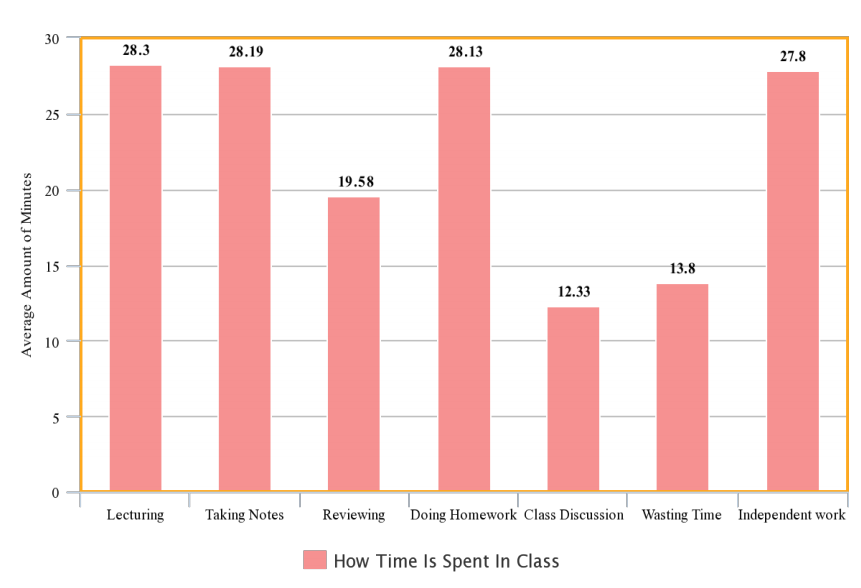How time is being spent in class
Judging by the first nine weeks of distance learning, there have been substantial changes in the structure of many Diamond Bar High School classes compared to in-person instruction.
Twenty-one Bull’s Eye staff members tracked how each teacher used their class time, showing a variety of results from core classes such as English, math and foreign language.
A surprisingly large portion of the time spent during classes is used for attendance. During in-class schooling, attendance usually takes a minute or two as teachers could quickly look over the class and see who was missing using their seating chart. With distance learning, the average amount of time it took to take attendance was much greater, averaging from five to seven minutes.
In more classes than usual, working on homework seemed to take up a large portion of the class period. For example, many students reported that their teacher took attendance for five minutes, and then the students were free to work on their homework for the remaining 35 minutes. Even during the extra 6L and 1L periods, students observed attendance taking about 5 minutes and then frequent homework periods. In the week the students kept track, there were about 20 reports of classes that included students working on homework for the duration of class.
According to the data, on average, every day around 30 minutes were used on lecturing, taking notes, doing homework or independent work/classwork. Twelve minutes was used for class discussion, 20 minutes was used for reviewing homework, and only about 15 minutes were used on other random discussions. The info shows how much time goes into homework, as it is as much as everyday activities such as classwork and lecture.
Some students had classes that needed extra time for classwork, resulting in more homework. For example, in Trigonometry/Math Analysis, English 2 Honors, AP Euro, and AP Computer Science Principles, little time was used for attendance while the majority of the period was spent note-taking and reviewing homework. However, even with this extra time, the students reported that there was not enough time to finish classwork, resulting in extra assignments outside of class.
In many classes, students took notes on Google slides or other presentation material outside of class, in order to stay on track with current lessons, which appears to be common among math teachers. This is a big gap from in-seat schooling, where note taking from lectures took place almost entirely during class time.
Some teachers organized their periods to include participation opportunities. For example, students noted that in some classes, after attendance, the majority of the time left consisted of doing classwork activities and verbal participation. Some students also reported taking part in discussion about different topics and doing activities such as Kahoot or Quizizz in their foreign language classes.
In some English classes, students spent the majority of their time reviewing past assignments such as reading comprehension problems or looking at essays, while others took note of activities such as vocab review and video notes. Overall, each English teacher seemed to have a unique way in how they went about their lessons.
There were few comments about physical education, as the contents were rather unchanged according to the data. Students reported that their teachers would have them do physical workouts together over Zoom. However, what was altered was the variety of physical activities in classes.
As activities such as basketball or running miles are impossible to set up virtually, teachers had students do exercises, such as no-equipment ones like cardio and body-weight workouts. Sometimes, they also encouraged students to bring weights to do weight training exercises, with students being able to bring light weights such as textbooks or even heavier ones such as dumbbells in order to challenge themselves.
Your donation will support the student journalists of Diamond Bar High School. Your contribution will allow us to purchase equipment and cover our annual website hosting costs.



